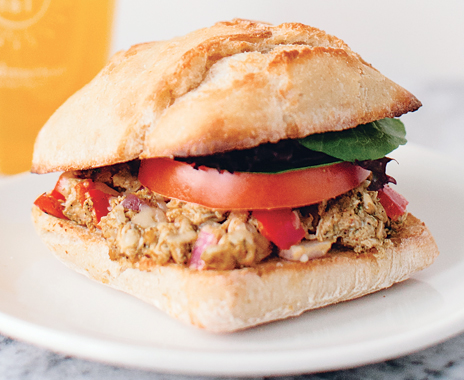More limited-service operators are phasing out food products from animals treated with nontherapeutic antibiotics and hormones as consumers air concerns over the human and animal welfare impact of such practices. But as brands large and small embrace more naturally raised meat and poultry, they face challenges ranging from supply chain limits to operating costs.
Concerns about overuse of antibiotics in animal agriculture have grown alongside research that finds routinely giving animals nontherapeutic antibiotics threatens human health by promoting antibiotic resistance. Next year, the U.S. government plans to start collecting more detailed data on antibiotics used on farms as a potential precursor for reduced-use targets.
Yet antibiotics are still added in massive quantities to animal feed—not to treat disease, but to promote faster growth and stave off illnesses caused by raising livestock in cramped and sometimes unsanitary conditions.
“We’re trading off efficiency in the current model for human health problems,” says Arlin Wasserman, founder and partner at Gaithersburg, Maryland–based consultancy Changing Tastes. “Science, government, and certainly diners say that tradeoff is not worth it.”
Citing the changing preferences and demands of its customers, McDonald’s announced in March plans to stop serving chicken raised with antibiotics used to treat humans from all U.S. restaurants. The policy—which excludes certain antibiotics that increase feed efficiency and body weight gain, for example—is in line with the U.S. Food and Drug Administration’s (FDA) voluntary approach in which animal drug companies are asked to stop selling drugs used as human medicine.
The chain also said it will begin sourcing milk for its Milk Jug low-fat milk and Milk Jug fat-free chocolate milk that’s free from synthetic recombinant growth hormone (RBST)—an already widely adopted practice among restaurants and retailers.
Because McDonald’s efforts only partially address the antibiotic issue (“Where’s the beef?” asks Wasserman), some are dismissing the latest moves as “greenwashing.” But given the brand’s purchasing power, it’s a step in the right direction.
“Sure, it’s a lip-service move, but they’ve set a new low bar for chicken quality that will accelerate change,” Wasserman says. “Chick-fil-A, Panera, Compass Group—none of those alone is a large enough buyer to create wholesale change. McDonald’s has the purchasing power, so it’s good for the industry overall. I just wish they’d been proactive on beef.”
Justin Ransom, Ph.D., senior director of quality systems for McDonald’s U.S. supply chain management, says the company has yet to set a firm timeline on antimicrobial beef. In November, McDonald’s announced it would roll out a pilot program for sustainable beef in Canadian restaurants. The program comes out of the newly formed U.S. Roundtable for Sustainable Beef (USRSB), which will set nonbinding standards for sustainable beef.
“We are committed to our global vision for antimicrobial stewardship, and we will be working with our stakeholders as we determine criteria and verification expectations and timelines,” Ransom says. “This engagement is a critical step in support of the company’s … effort to source verified sustainable beef.”
Anthony Pigliacampo, cofounder of Boulder, Colorado–based fast-casual chain Modmarket, says that given the complexity of creating a reliable, antibiotic-free supply chain coupled with longer commitments for cattle—which take two and a half years to reach slaughter weight, compared with 10–12 weeks for chickens—he isn’t surprised McDonald’s hasn’t made the move to antibiotic-free beef.
“This movement has been more of a grassroots one led by smaller companies,” he says. “Big brands fall into the trap of having to create concise marketing messages. Small companies can suss this stuff out while remaining totally transparent with consumers.”
Modmarket has been sourcing humanely raised, hormone- and antibiotic-free meat and poultry since it launched with a single unit in 2009. It now operates 12 restaurants across Colorado and Texas.
“When we started out at a very high level, we said we wanted humanely raised, antibiotic-free meat and poultry,” Pigliacampo says. “But we quickly learned that when it comes to antibiotics in meat, there are incredible shades of gray. For example, most meat labeled hormone- or antibiotic-free usually means the animal hasn’t been fed any for a certain period of time.”
It could also refer to an antibiotic implant inserted after birth to help fatten the animal that was later removed, or a sick calf that was given antibiotics as opposed to being killed—a practice Modmarket supports, Pigliacampo says. Few suppliers have control of the product before it arrives or after it leaves.
“It starts dwindling the pool of people you can buy from,” he says. “But it also started to inform our view on what’s realistic and what’s possible.”
Chipotle, a forerunner in using naturally raised meats, has among the highest food costs in the industry as a percentage of revenue, but it also boasts some of the best profit margins, says Chris Arnold, director of communications at the Denver-headquartered chain.
It helps that the brand started down this path “when we were relatively small,” Arnold says. (The 1,700-location chain first started serving antibiotic-, hormone-free pork from San Francisco–based Niman Ranch in 2000, when it operated some 100 restaurants.)
Because Chipotle’s protocols extend beyond antibiotic-free to include housing standards for livestock, it’s taken years to secure adequate supply. Moreover, meat raised to these standards costs more, thus requiring price increases.
“We have seen over the years that our customers are willing to pay more for food they recognize is better,” Arnold says, adding that the brand’s goal is to ultimately change the perception of fast food.
Wasserman says competition from “better” fast-food chains like Chipotle and New York–based Shake Shack is already forcing McDonald’s to shift its focus away from speed and price toward quality and flavor. But the next moves, he adds, are up to new McDonald’s CEO Steve Easterbrook.
“There isn’t enough antibiotic-free beef in the U.S., so it would require at least a two-year commitment allowing new animals to be born and raised to smaller weights,” Wasserman says. “But if [Easterbrook’s] goal is that McDonald’s be seen as a quality vendor, there’s no reason he can’t make that commitment.”










